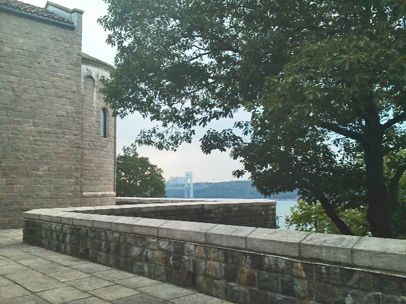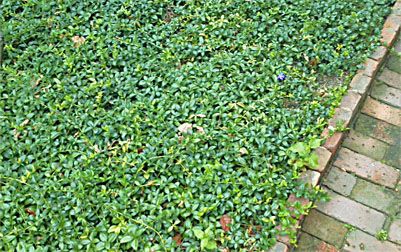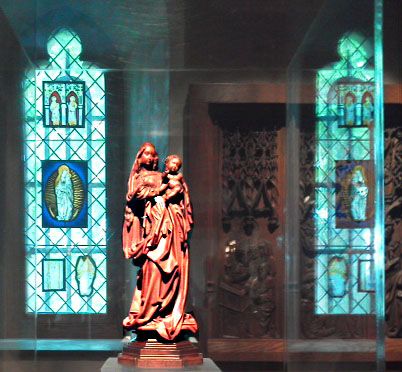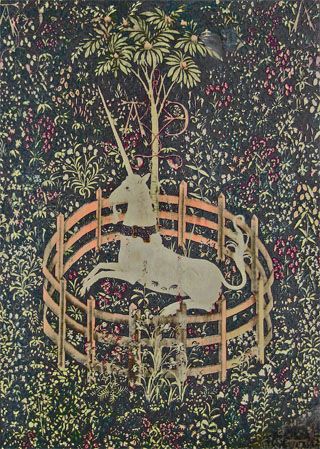
Cloisters Terrace With a View of the George Washington Bridge
[Photo by KPA, August 2012]
Above is a photo I took from Cloisters' terrace with a view of the George Washington Bridge and the Hudson River (it is the background image on my tablet). Across the river is New Jersey, and the undeveloped stretch of land is the New Jersey Palisades. John D. Rockefeller had the Cloisters built especially to house his medieval collection. He also bought several acres of the Palisade hills across the river in order to have the best view possible from the Cloisters.
Below is a Wikipedia image of the Palisades with the Hudson River and the George Washington Bridge (more on the Palisades at the link provided):

Below are photos I took of the cloisters.

Garden in the Cloisters
Discussed in: Garden Guide: New York City pp. 33-37
Cloisters Flowers
[Photo by KPA, August 2012]
According the the Garden Guide: New York City, the Cloister Gardens are divided into three sections:
- The Cuxa Cloister Garth Garden, which
was assembled from the remnants of a Romanesque (eleventh century) Benedictine monastery, Saint-Michel-de-Cuxa, located in the French Pyrenees...
This space demonstrated key elements of the medieval garden: it is enclosed, rigorously symmetrical, and organized around a central feature, here a handsome fountain.
- The Bonnefont Cloister Herb Garden
On the lower level of the museum is the Bonnefont Cloister, a tidy working herb garden that, except for the stunning views of the George Washington Bridge in the distance, looks like a page from a medieval script.
- The Trie Cloister Garden,
...named for the Carmelite convent in Trie-en-Bigorre in south-western France, the original site for much of the stonework.

Periwinkles in the Cloisters
Discussed in Garden Guide: New York City pp. 33-37
Periwinkle Label:
Common Periwinkle, Myrtle
Vinca minor
[Photo by KPA, August 2012]
The information plaque by the periwinkle bed describes the flower as a medieval cancer treatment.
Annual periwinkles have been used for centuries for folk medicine, especially for treating diabetes, and are the source of several cancer drugs.And from this site, on the meaning of the flower's name:
The Latin name of periwinkle's genus, Vinca, is derived from a word meaning "to overcome."Such a small flower, with such a sturdy name!
Below is a single flower, standing its ground. Although the flower bed nearby is full of periwinkles, this one flower stood out amidst a hostile leaves.

Sturdy Periwkinle in the Cloisters Garden
Discussed in: Garden Guide: New York City pp. 33-37
Periwinkle Label:
"Common Periwinkle, Myrtle
Vinca minor
[Photo by KPA, August 2012]

[Photo by KPA, August 2012]

Standing Virgin and Child
Attributed to Nikolaus Gerhaert van Leiden
(North Netherlandish, active in Strasbourg, 1460–1473)
Date: ca. 1470
Medium: Boxwood, tinted lips and eyes
Dimensions: 13 1/4 x 5 1/8 x 3 9/16 in.
[Photo by KPA, August 2012]
Above is a photo I took of The Standing Virgin at the Cloisters Medieval Gallery in New York. She is enclosed in glass. I wasn't aware that I couldn't use my flash. The museum staff were quick to point that out to me, upon seeing the sudden flash of light. I apologized - I really don't want to participate in the destruction of these beautiful pieces. The damage was done, but I got the lovely photo above, with the light glowing on the faces of Mary and Jesus, and on the folds of Mary's robe. The stained glass window on the left, part of the collection in the Treasury, is reflected in the glass on the right.

The Unicorn in Captivity
South Netherlandish, 1495-1505
Wool warp with wool, silk, sliver, and gilt wefts
12ft. 7/18 in. x 8 ft. 3 in.
The Cloisters, Metropolitan Museum of Art
Gift of John D. Rockefeller Jr., 1937
Here's what I wrote about the Unicorn Tapestry in 2008:
Here is a link to the Met, which has details of the flowers on the tapestry:
The Unicorn Tapestries: Flowers, Plants and Trees
I had been wanting to see the Unicorn Tapestries at the Cloisters for many years. I have blogged about them here, and even written about their floral designs in this article (posted on my blog) on plants in the decorative arts (the original pdf article is on pp 3-4 of the Summer 2007 issue of the Botanical Artists of Canada Newsletter). As I wrote in my blog post in 2010 (when I first wanted to see them):Finally, I got to see them during my trip in New York this past August. I tried to take photos (without my flash, as instructed by the guards), but couldn't come up with any decent images, so I had to make do with a postcard of The Unicorn in Captivity from the gift shop.I have never been to The Cloisters, but have always known that they house the beautiful tapestries The Hunt of the Unicorn. But, I was lucky to see another set of unicorn tapestries, The Lady and the Unicorn (La Dame à la Licorne), housed in the Musée de Cluny, in Paris.And from my article:One of the most enchanting mergers of scientific observation and religious symbolism are the tapestries of the Hunt of the Unicorn. These tapestries are covered with the late Medieval tradition of fields of millefleurs. When analyzed carefully, many of these flowers are clearly identifiable, in their correct environment. The Madonna Lily, depicted in The Unicorn in Captivity tapestry, is both a religious symbol of the purity of Mary and also a medicinal plant that treated burns, ulcers and ear infections, amongst other things.
-----------------------------------------------------------------------------------------------------------------------------------------------------
By: Kidist P. Asrat
